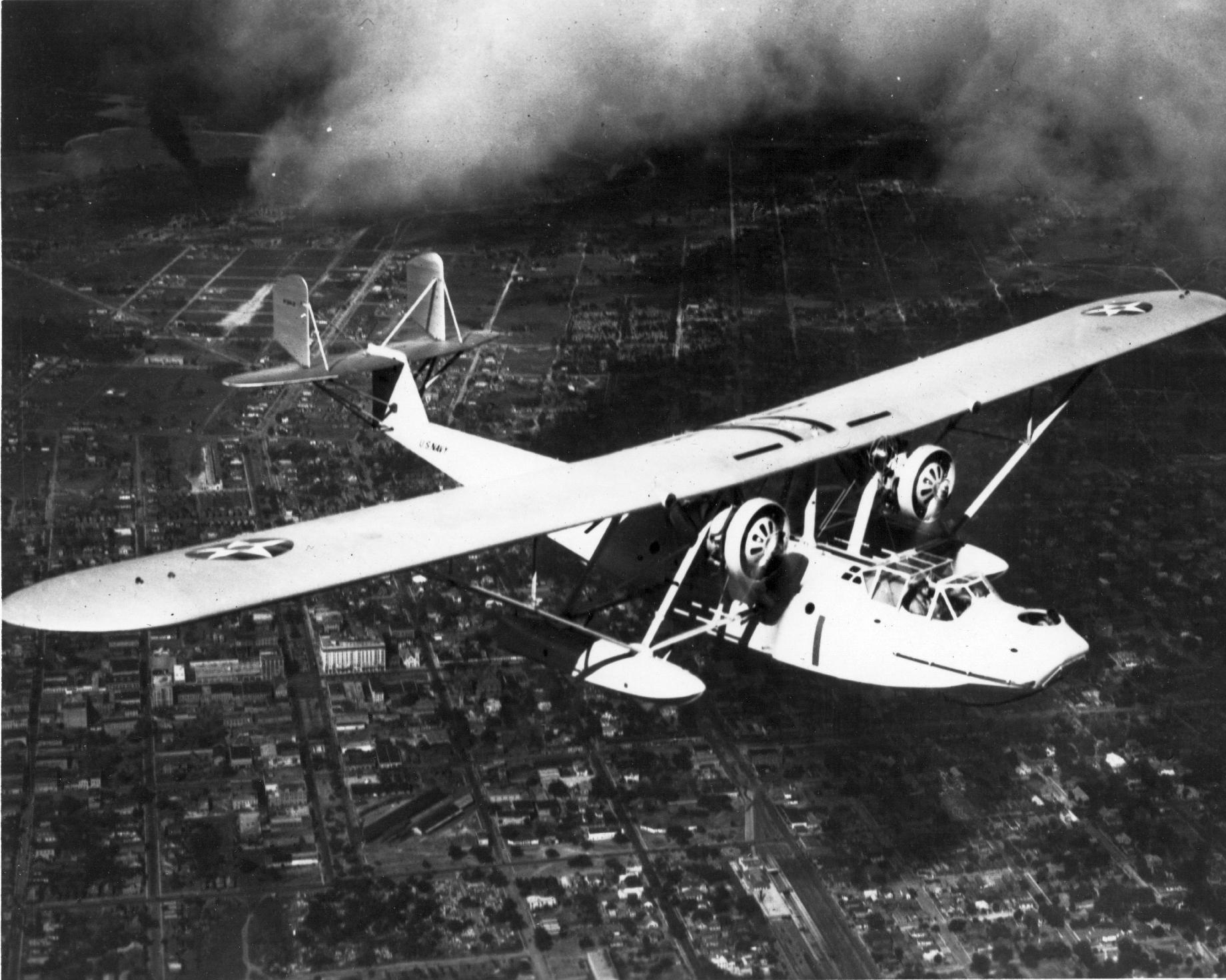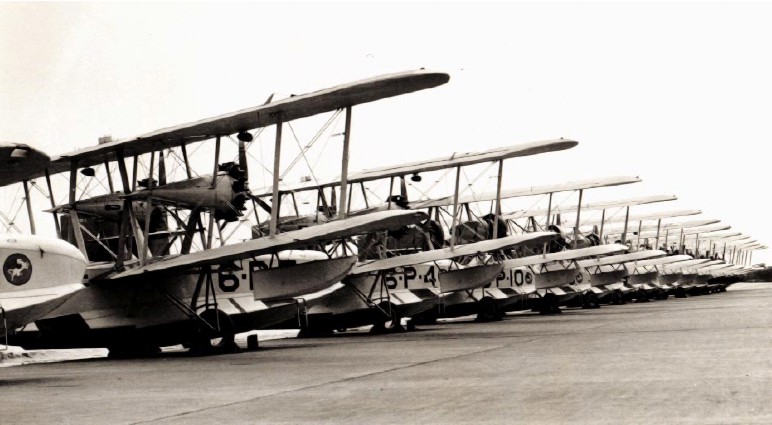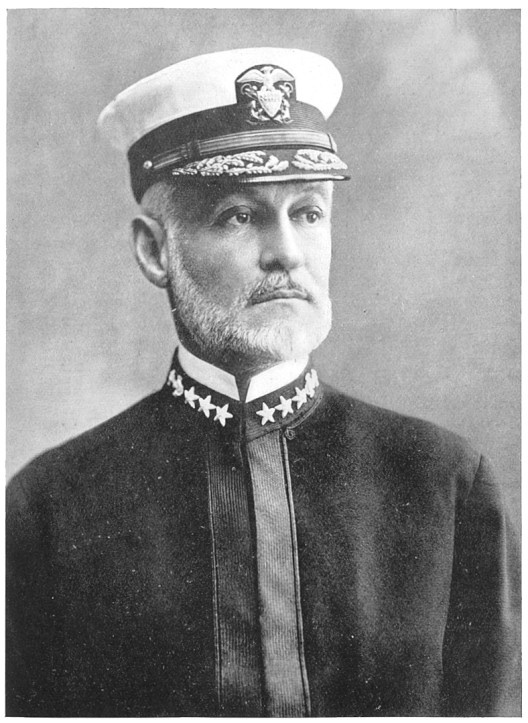|
VP-22
VP-22 was a Patrol Squadron of the U.S. Navy. The squadron was established as Patrol Squadron 4D-14 (VP-4D14) on 15 September 1928, redesignated Patrol Squadron 4-B (VP-4B) on 21 January 1931, redesignated Patrol Squadron 4-F (VP-4F) on 17 July 1933, redesignated Patrol Squadron 4 (VP-4) on 1 October 1937, redesignated Patrol Squadron 22 (VP-22) on 1 July 1939 and disestablished on 18 April 1942, with the squadron assets merged with VP-101. Operational history *15 September 1928: VP-4D14 established at NAS Pearl Harbor, Hawaii, with the D14 representing the 14th Naval District. The squadron began operations with six H-16 seaplanes. Primary mission of the squadron was patrol and bombing in connection with the plan of defense for the Hawaiian Islands. *20 February 1929: Mechanics from the Wright Aeronautical Corporation arrived to begin alterations on the engines of the H-16 and new T2D aircraft. *28 February 1930: The first PD-1 aircraft was received by the squadron for testing ... [...More Info...] [...Related Items...] OR: [Wikipedia] [Google] [Baidu] |
VP-20
VP-20 was a Patrol Squadron of the U.S. Navy. The squadron was established as Patrol Squadron 8-S (VP-8S) from elements of VT-9S on 1 July 1929, redesignated Patrol Squadron 8-F (VP-8F) on 3 April 1933, redesignated Patrol Squadron 8 (VP-8) on 1 October 1937, redesignated Patrol Squadron 24 (VP-24) on 1 July 1939, redesignated Patrol Squadron 12 (VP-12) on 1 August 1941, redesignated Patrol Bombing Squadron 120 (VPB-120) on 1 October 1944, redesignated Patrol Squadron 120 (VP-120) on 15 May 1946, redesignated Heavy Patrol Squadron (Landplane) 10 (VP-HL-10) on 15 November 1946, redesignated Patrol Squadron 20 (VP-20) on 1 September 1948 and disestablished on 31 March 1949. It was the third squadron to be designated VP-20, the first VP-20 was redesignated VP-44 on 1 July 1940 and the second VP-20 was redesignated VPB-20 on 1 October 1944. Operational history *1 July – September 1929: A detachment of six aircraft and crews from VT-9S were used to provide the cadre for the establis ... [...More Info...] [...Related Items...] OR: [Wikipedia] [Google] [Baidu] |
VPB-29
VPB-29 was a Patrol Bombing Squadron of the U.S. Navy. The squadron was established as Pacific Air Detachment on 17 January 1923, redesignated Patrol Squadron 14 (VP-14) on 29 May 1924, redesignated Patrol Squadron 1-Naval District 14 (VP-1D14) on 21 September 1927, redesignated Patrol Squadron 1-B (VP-1B) on 1 July 1931, redesignated Patrol Squadron 1-F (VP-1F) on 15 April 1933, redesignated Patrol Squadron 1 (VP-1) on 1 October 1937, redesignated Patrol Squadron 21 (VP-21) on 1 July 1939, redesignated Patrol Squadron 1 (VP-1) on 30 July 1940, redesignated Patrol Squadron 101 (VP-101) on 3 December 1940, redesignated Patrol Bombing Squadron 29 (VPB-29) on 1 October 1944 and disestablished on 20 June 1945. Operational history *17 January 1923: Pacific Air Detachment, Naval Station Pearl Harbor, Navy Yard Pearl Harbor, Hawaii, was formed with a hodgepodge of aircraft types. Aircraft assigned to the new unit consisted of Felixstowe F5L, F-5L, Douglas DT, DT and Curtiss Model H, H-1 ... [...More Info...] [...Related Items...] OR: [Wikipedia] [Google] [Baidu] |
VP-21
VP-21 was a Patrol Squadron of the U.S. Navy. The squadron was established as Patrol Squadron 7-B (VP-7B) on 23 July 1929, redesignated Patrol Squadron 7-F (VP-7F) on 1 July 1931, redesignated Patrol Squadron 7 (VP-7) on 1 October 1937, redesignated Patrol Squadron 11 (VP-11) on 1 July 1939, redesignated Patrol Squadron 21 (VP-21) on 1 February 1941 and disestablished on 18 April 1942, with the squadron assets merged with VP-101. It was the third squadron to be designated VP-21, the first VP-21 was redesignated VP-45 on 1 July 1939 and the second VP-21 was redesignated VP-1 on 30 July 1940. Operational history *23 July 1929: Patrol Squadron 7-B was established at NAS San Diego, California, with six NB-1 floatplanes from the assets of the disestablished squadron VN-7D11. VP-7B came under the operational command of the Battle Fleet. Tender support was provided at that time by . PD-1 aircraft soon replaced the NB-1s. Training of flight crews continued through February 1930. *26 Ju ... [...More Info...] [...Related Items...] OR: [Wikipedia] [Google] [Baidu] |
VPB-23
VPB-23 was a patrol bombing squadron of the U.S. Navy. The squadron was established as Patrol Squadron 10-S (VP-10S) on 1 July 1930, redesignated Patrol Squadron 10-F (VP-10F) on 17 July 1933, redesignated Patrol Squadron 10 (VP-10) on 1 October 1937, redesignated Patrol Squadron 25 (VP-25) on 1 July 1939, redesignated Patrol Squadron 23 (VP-23) on 1 August 1941, redesignated Patrol Bombing Squadron 23 (VPB-23) on 1 October 1944 and disestablished on 25 January 1946. Operational history *1 July 1930: Torpedo Squadron NINE-S ( VT-9S) was redesignated at NAS Hampton Roads, Virginia, and the assets of the squadron were utilized to form Patrol Squadron 10S under the operational control of the Scouting Fleet. *1 September 1930: The squadron's twin-float T4M torpedo bombers were turned in for PM-1 flying boats. Tender support for the squadron's six PM-1 aircraft was provided by . *8 February 1931: VP-10S participated in Fleet Problem XII with VP-8, VP-3 and VP-5 in the Caribbean. Sq ... [...More Info...] [...Related Items...] OR: [Wikipedia] [Google] [Baidu] |
VPB-11
VPB-11 was a Patrol Bombing Squadron of the U.S. Navy. The squadron was established as Torpedo & Bombing Squadron 19-D14 (VT-19D14) on 7 February 1924, redesignated Torpedo & Bombing Squadron 6D14 (VT-6D14) on 1 July 1927, redesignated Patrol Squadron 6-B (VP-6B) on 1 April 1931, redesignated Patrol Squadron 6-F (VP-6F) on 17 July 1933, redesignated Patrol Squadron 6 (VP-6) on 1 October 1937, redesignated Patrol Squadron 23 (VP-23) on 1 July 1939, redesignated Patrol Squadron 11 (VP-11) on 1 August 1941, redesignated Patrol Bombing Squadron 11 (VPB-11) on 1 October 1944 and disestablished on 20 June 1945. Operational history *7 February 1924: VT-19 was established as a torpedo squadron based at NAS Ford Island, Pearl Harbor, Hawaii, flying 13 DT-2 aircraft. *25 April 1925: Several of the squadron’s pilots made the first successful night landings on an aircraft carrier under way. The landings, made under varying lighting and weather conditions, were part of a program to determ ... [...More Info...] [...Related Items...] OR: [Wikipedia] [Google] [Baidu] |
Consolidated P2Y
The Consolidated P2Y was an American flying boat maritime patrol aircraft. The plane was a parasol monoplane with a fabric-covered wing and aluminum hull. Development Initially created to compete for a U.S. Navy contract dated February 28, 1928, the prototype Model 9, XPY-1, was designed by Captain Dick Richardson and Isaac M. 'Mac' Laddon. Beginning construction in March 1928, the aircraft was ready for its first flight by the end of the year. Lieutenant A. W. Gorton made the first flight out of Anacostia NAS, Washington, D.C.Donald 1997, p. 268. The production contract was opened to other bidders, and the Glenn L. Martin Company undercut them and was awarded the contract to construct the plane as the Martin P3M-1 and P3M-2. Three P3M-1s and six P3M-2s were built; one XP2M-1 was also built to a similar design, powered by three Wright Cyclone engines; following the removal of the third engine it was redesignated XP2M-2. The idea of a third engine on the XPY-1 had been stud ... [...More Info...] [...Related Items...] OR: [Wikipedia] [Google] [Baidu] |
Naval Aircraft Factory PN
The Naval Aircraft Factory PN was a series of open cockpit American flying boats of the 1920s and 1930s. A development of the Felixstowe F5L flying boat of the First World War, variants of the PN were built for the United States Navy by Douglas, Keystone and Martin. Development and design The PN flying boats were twin-engine biplanes with their engines mounted in nacelles between the fabric-covered wings. Other than on the PN-11 which had a different hull form, the hull had large chines running back to the first step similar to those on the F.5L. It had a standard crew of five, but was capable of carrying a relief crew for long patrols. Early machines had wood hulls and wings, with the wings covered in fabric, while various versions replaced these with metal components. A wide variety of V-12 and radial engines were fitted, due to problems with several of the engines chosen, with later versions generally using radial engines. At the end of World War I the United States Navy ... [...More Info...] [...Related Items...] OR: [Wikipedia] [Google] [Baidu] |
Chief Of Naval Operations
The chief of naval operations (CNO) is the professional head of the United States Navy. The position is a statutory office () held by an admiral who is a military adviser and deputy to the secretary of the Navy. In a separate capacity as a member of the Joint Chiefs of Staff (), the CNO is a military adviser to the United States National Security Council, National Security Council, the United States Homeland Security Council, Homeland Security Council, the United States Secretary of Defense, secretary of defense, and the President of the United States, president. The current chief of naval operations is Michael M. Gilday, Admiral Michael M. Gilday. Despite the title, the CNO does not have operational command authority over naval forces. The CNO is an administrative position based in the Pentagon, and exercises supervision of Navy organizations as the designee of the secretary of the Navy. Operational command of naval forces falls within the purview of the Unified combatant comma ... [...More Info...] [...Related Items...] OR: [Wikipedia] [Google] [Baidu] |
VP-102
VP-102 was a Patrol Squadron of the U.S. Navy. It was established as VP-18 on 1 September 1937, redesignated as VP-13 on 1 July 1939, redesignated as VP-26 on 11 December 1939, redesignated as VP-102 on 16 December 1940 and disestablished on 18 April 1942. Operational history *1 September 1937–January 1938: VP-18 was established at NAS Seattle, Wash., by CNO and BuAer for administrative purposes. Formation of the squadron proceeded slowly, with official establishment ceremonies being held on 15 December 1937. The squadron did not receive its first aircraft until 15 January 1938, when 15 P2Y-3 seaplanes were transferred from VP-4. One, possibly two, PBY-1 aircraft were also part of the squadron complement for conversion training when more of the Catalinas became available. Although located at NAS Seattle during its formation, VP-18 came under the operational control of Patrol Wing-2, located at Naval Station Pearl Harbor, Hawaii. *25 March 1938: Aircraft of Patrol Wing 2 part ... [...More Info...] [...Related Items...] OR: [Wikipedia] [Google] [Baidu] |
VP-5
Patrol Squadron FIVE (VP-5) is a long-lived maritime patrol squadron of the United States Navy. It is the second squadron to bear the VP-5 designation. VP-5 is the second oldest patrol squadron, the fourth oldest in the United States Navy, and the 33rd oldest squadron in the United States military. As of 2019, VP-5 is still active and is based at Naval Air Station Jacksonville, Florida. Lineage The squadron was originally established as Patrol Squadron 17-F (VP-17F) on 2 January 1937, redesignated Patrol Squadron 17 (VP-17) on 1 October 1937, redesignated Patrol Squadron 42 (VP-42) on 1 July 1939, redesignated Bombing Squadron 135 (VB-135) on 15 February 1943, redesignated Patrol Bombing Squadron 135 (VPB-135) on 1 October 1944, redesignated Patrol Squadron 135 (VP-135) on 15 May 1946, redesignated Medium Patrol Squadron (Landplane) 5 (VP-ML-5) on 15 November 1946 and redesignated Patrol Squadron 5 (VP-5) on 1 September 1948. It was the second squadron to be designated VP-5, the ... [...More Info...] [...Related Items...] OR: [Wikipedia] [Google] [Baidu] |
VP-3
VP-3 was a Patrol Squadron of the U.S. Navy. The squadron was established as Patrol Squadron 16-F (VP-16F) on 2 January 1937, redesignated Patrol Squadron 16 (VP-16) on 1 October 1937, redesignated Patrol Squadron 41 (VP-41) on 1 July 1939, redesignated Bombing Squadron 136 (VB-136) on 1 March 1943, redesignated Patrol Bombing Squadron 136 (VPB-136) on 1 October 1944, redesignated Patrol Squadron 136 (VP-136) on 15 May 1946, redesignated Medium Patrol Squadron (landplane) 3 (VP-ML-3) on 15 November 1946, redesignated Patrol Squadron 3 (VP-3) on 1 September 1948, and was disestablished on 1 November 1955. It was the second squadron to be designated VP-3, the first VP-3 was redesignated VP-32 on 1 July 1939. Operational history *2 January 1937: VP-16F was established at NAS Seattle, Washington, as a patrol squadron composed of 12 PM-1 flying boats. provided tender support. *1 October 1937: VP-16F was redesignated VP-16 when all patrol squadrons were reassigned to Patrol Wings. V ... [...More Info...] [...Related Items...] OR: [Wikipedia] [Google] [Baidu] |
Fleet Problem
The Fleet Problems are a series of naval exercises of the United States Navy conducted in the interwar period, and later resurrected by Pacific Fleet around 2014. The first twenty-one Fleet Problems — labeled with roman numerals as Fleet Problem I through Fleet Problem XXI — were conducted between 1923 and 1940. They were usually once-a-year exercises in which U.S. naval forces would engage in mock battles. One or more of the forces would play the part of a European or Asian navy. They were the culmination of the Navy's annual training maneuvers. Fleet Problem XXII, scheduled for 1941, was canceled because of the rising tensions with Japan that led to the US' entry into World War II. Following the outbreak of war, Fleet Problems underwent a prolonged hiatus, with other names being used to describe large American naval exercises. However, the term was revived in the 21st century under Admiral Scott H. Swift, with Fleet Problem XXIII through XXVIII taking place in the Pacific ... [...More Info...] [...Related Items...] OR: [Wikipedia] [Google] [Baidu] |








%2C_USS_Lexington_(CV-2)_and_USS_Saratoga_(CV-3)_at_anchor_off_Honolulu_on_8_April_1938_(80-G-410056).jpg)